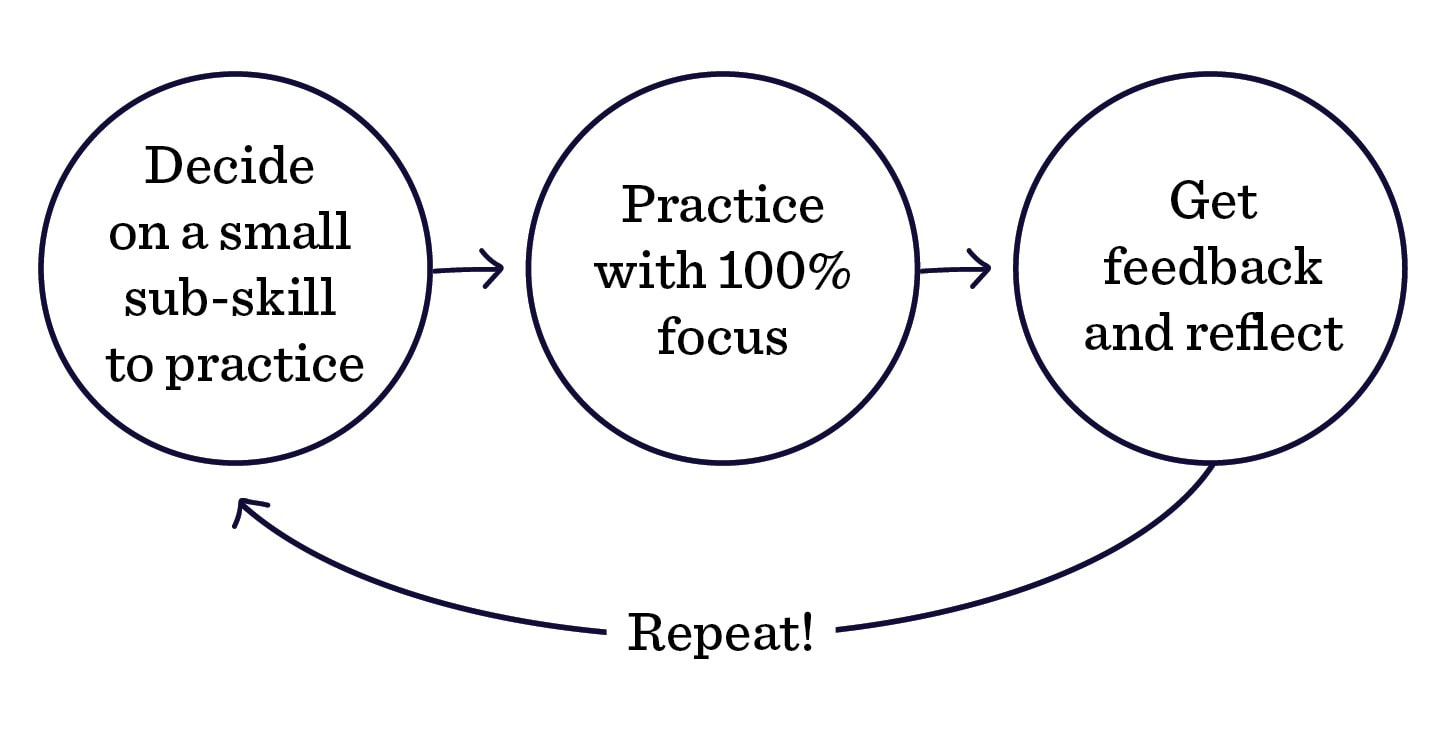|
What is Expert Practice?It’s often assumed that world-class performers have a gift or talent the rest of us lack. Experts do share something that sets them apart, but it’s not just “natural ability”—it’s ability they developed through a special type of practice. Expert Practice has three steps that maximize learning. First, a student and teacher identify a specific sub-skill that incrementally challenges the student. Second, the student practices that skill with full effort. Third, the teacher gives feedback. By repeating this cycle, students will learn to replace “going through the motions” with the kind of purposeful effort that leads to true learning. Expert Practice can help students master a wide array of skills both inside and out of the classroom. It’s often assumed that world-class performers have a gift or talent the rest of us lack. Experts do share something that sets them apart, but it’s not just “natural ability”—it’s ability they developed through a special type of practice. Watch the 1-minute video.
www.youtube.com/watch?v=GsYSijG-EiM At its core, music theory helps students understand how a piece of music works. When learning music, students may find themselves wondering why a certain note was chosen or what those funny symbols in a piece of sheet music actually mean. Fortunately, music theory helps students answer these questions, and many more. An understanding of intervals, scales, and keys will help students see why notes are placed together, or why a sharp or a flat makes sense in a certain context. For students who want to play in an ensemble or band, music theory will show them where their part is in the group–making it easier for them to play with other musicians. Whether they’re casually jamming in a garage or playing in an official band or orchestra, understanding how written music works will make it easier for them to play in harmony with other musicians.
The music information and theory pages below will help you learn the names of notes, rhythms, instruments, terms and the names of famous musicians and composers. These pages may help you with some of the Music Quizzes and Games. www.musictheory.net/lessons www.musictechteacher.com/music_quizzes/music_quizzes.htm 1. Seek out instruction: Find an experienced teacher who knows what you should be doing. A good teacher will help you understand the purpose of practicing and can teach you ways to make practicing easier and more productive.
2. Write out a schedule: A schedule helps you organize your time. Be sure to allow time to review the fundamentals because they are the foundation of all the complicated things that come later. If you are practicing basketball, for example, be sure to put time in your schedule to practice free throws. 3. Set goals: Like a schedule, goals help you organize your time and chart your progress. Goals also act as a challenge: something to strive for in a specific period of time. If a certain task turns out to be really difficult, relax your goals: practice doesnʼt have to be painful to achieve results. 4. Concentrate: You can do more in 10 minutes of focused practice than in an hour of sighing and moaning. This means no video games, no television, no radio, just sitting still and working. Start by concentrating for a few minutes at a time and work up to longer periods gradually. Concentrated effort takes practice too, especially for young people. 5. Relax and practice slowly: Take your time; donʼt rush through things. Whenever you set out to learn something new – practicing scales, multiplication tables, verb tenses in Spanish – you need to start slowly and build up speed. 6. Practice hard things longer: Donʼt be afraid of confronting your inadequacies; spend more time practicing what you canʼt do. Adjust your schedule to reflect your strengths and weaknesses. Donʼt spend too much time doing what comes easily. Successful practice means coming face to face with your shortcomings. Donʼt be discouraged; youʼll get it eventually. 7. Practice with expression: Every day you walk around making yourself into “you,” so do everything with the proper attitude. Put all of yourself into participating and try to do your best, no matter how insignificant the task may seem. Express your “style” through how you do what you do. 8. Learn from your mistakes: None of us are perfect, but donʼt be too hard on yourself. If you drop a touchdown pass, or strike out to end the game, itʼs not the end of the world. Pick yourself up, analyze what went wrong and keep going. Most people work in groups or as part of teams. If you focus on your contributions to the overall effort, your personal mistakes wonʼt seem so terrible. 9. Donʼt show off: Itʼs hard to resist showing off when you can do something well. In high school, I learned a breathing technique so I could play a continuous trumpet solo for 10 minutes without stopping for a breath. But my father told me, “Son, those who play for applause, thatʼs all they get.” When you get caught up in doing the tricky stuff, youʼre just cheating yourself and your audience. 10. Think for yourself: Your success or failure at anything ultimately depends on your ability to solve problems, so donʼt become a robot. Think about Dick Fosbury, who invented the Fosbury Flop for the high jump. Everyone used to run up to the bar and jump over it forwards. Then Fosbury came along and jumped over the bar backwards, because he could go higher that way. Thinking for yourself helps develop your powers of judgment. Sometimes you may judge wrong and pay the price; but when you judge right you reap the rewards. 11. Be optimistic: How you feel about the world expresses who you are. When you are optimistic, things are either wonderful or becoming wonderful. Optimism helps you get over your mistakes and go on to do better. It also gives you endurance because having a positive attitude makes you feel that something great is always about to happen. 12. Look for connections: No matter what you practice, youʼll find that practicing itself relates to everything else. It takes practice to learn a language, cook good meals or get along well with people. If you develop the discipline it takes to become good at something, that discipline will help you in whatever else you do. Itʼs important to understand that kind of connection. The more you discover the relationships between things that at first seem different, the larger your world becomes. In other words, the woodshed can open up a whole world of possibilities. Baritone/ Euphonium- Playing The First Five Notes
www.youtube.com/watch?v=vY05WKmuqA8 Trombone/Baritone Horn - The Mouthpiece www.youtube.com/watch?v=JNV--1WCHrc Trombones have been around for over 600 years. In the beginning there were four different kinds of trombones used. There was a soprano, an alto, a tenor and a bass. Today the symphony orchestra usually has two tenor and one bass trombone. At one time in the 19th century trombones had valves like other brass instruments. But that style didn’t last.The trombone sounds as written which is different from other brass instruments. This is true because it sounds the note as written in the music. It is the brass instrument that uses the glissando the most. It is a long brass tube that is folded back on itself sort of like a paper clip. The mouthpiece of a trombone is pretty large and is cup-shaped. You play the trombone by sliding tubing back and forth to make the tube longer or shorter. This changes the sound. A trombone has seven positions. To make other pitches the player changes his lip shape. When he squeezes or loosens his lips this changes the sound. A trombone can also do a glissando, which is where the player goes up to a note or down from a note, playing all the notes in between by just moving the slide. The trombone is the only modern orchestral brass instrument that could play all the notes of the chromatic scale from the beginning. But they weren’t in early orchestras. Composers thought they were only for solemn music. When composers write music for the trombone they usually write it for three trombones to play at a time and they usually play the harmony.
Flute Assembly and Maintenance
Assembly• Always consult your teacher if you are not sure how to put together your instrument. • NEVER force the parts of your instrument together. • When assembling the flute only hold the non-keyed parts (the barrel and the bottom of the foot). • NEVER use lubrication of any kind. Maintenance• Wipe off your fingerprints after every use. A clean, non-treated cotton cloth will work the best. If you do choose to use a treated polishing cloth be sure that it is for a SILVER finished instrument. Using the wrong cloth could cause scratches. • Clean out the moisture from your instrument with an absorbent cloth or swab after every use. Clean the inside of all 3 sections of the flute. Removing the moisture from your flute before putting it away each time will prolong the life of the pads. • Always store your instrument in its case with the lid closed when not in use. This will prevent any excess tarnishing and lower the risk of damage. • Do not put anything (including sheet music) inside the case with your instrument that does not belong. Closing the case with extra contents can cause damage to the delicate keys. Also, make sure that all the latches are securely closed before transporting your instrument. Below you will find a video to help you with Flute Assembly, Disassembly and Daily Maintenance:
https://www.youtube.com/watch?v=X2pJhhJ1F6I
|
LSGA Instrumental Ensembles-
|


 RSS Feed
RSS Feed
